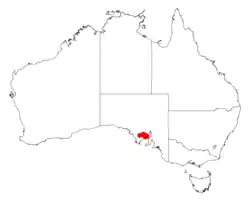Acacia cretacea
| Chalky wattle | |
|---|---|

| |
| Scientific classification | |
| Kingdom: | Plantae |
| Clade: | Tracheophytes |
| Clade: | Angiosperms |
| Clade: | Eudicots |
| Clade: | Rosids |
| Order: | Fabales |
| Family: | Fabaceae |
| Subfamily: | Caesalpinioideae |
| Clade: | Mimosoid clade |
| Genus: | Acacia |
| Species: | A. cretacea
|
| Binomial name | |
| Acacia cretacea | |

| |
| Occurrence data from AVH | |
| Synonyms[1] | |
|
Racosperma cretaceum (Maslin & Whibley) Pedley | |
Acacia cretacea, also known as chalky wattle,[2] is a species of flowering plant in the family Fabaceae and is endemic to South Australia. It is a spindly, straggy shrub or tree, with rather crowded, narrowly lance-shaped to narrowly elliptic, leathery phyllodes, spherical heads of lemon yellow to golden yellow flowers and firmly papery to thinly leathery, linear pods.
Description
Acacia cretacea is a spindly, straggly shrub or tree usually that typically grows to a height of up to 4 m (13 ft) and has glabrous branchlets covered with a white, powdery bloom. Its phyllodes are rather crowded on pronounced stem-projections, narrowly lance-shaped with the narrower end towards the base, to narrowly elliptic, 70–100 mm (2.8–3.9 in) long, 9–20 mm (0.35–0.79 in) wide and thin to leathery. The flowers are borne in spherical heads on racemes 20–40 mm (0.79–1.57 in) long on peduncles 4–11 mm (0.16–0.43 in) long. The racemes are covered with a white bloom, each head 4–5 mm (0.16–0.20 in) in diameter with 35 to 45 densely arranged lemon yellow to golden yellow flowers. Flowering occurs from about July to January, and the pods are linear, firmly papery to thinly leathery, up to 90 mm (3.5 in) long, 5–6 mm (0.20–0.24 in) wide and glabrous. The seeds are black, 5–7 mm (0.20–0.28 in) long with the attachment more than half the length of the seed, and a club-shaped aril.[2][3][4][5][6]
Taxonomy
Acacia cretacea was first formally described in 1987 by the botanists Bruce Maslin and David John Edward Whibley in the journal Nuytsia from specimens collected north-east of Coolanie on the Eyre Peninsula in 1983.[3][7] The specific epithet (cretacea) is a Latin word meaning chalk white in reference to the chalky coloured branchlets, flowers and seed pods.[2]
Distribution and habitat
Chalky wattle is restricted to north of Cowell on north-eastern Eyre Peninsula where it grows in deep red sand on gently undulating country with low sand ridges, in low shrubland and mallee scrub.[5] It is commonly associated with Eucalyptus incrassata, Melaleuca uncinata and Triodia irritans. It is restricted to an area approximately 8 km2 (3.1 sq mi) and has an estimated population a few hundred to 5,000 individual plants. Chalky wattle grows on roadsides and in adjacent farming land.[8]
Conservation status
Acacia cretacea is listed as "endangered" under the Australian Government Environment Protection and Biodiversity Conservation Act 1999 and as "endangered" under the South Australian Government National Parks and Wildlife Act 1972. The main threats to the species are habitat fragmentation and high grazing pressure.[8]
See also
References
- ^ a b "Acacia cretacea". Australian Plant Census. Retrieved 6 August 2025.
- ^ a b c Maslin, Bruce R.; Kodela, Phillip G. "Acacia cretacea". Flora of Australia. Australian Biological Resources Study, Department of Climate Change, Energy, the Environment and Water: Canberra. Retrieved 6 August 2025.
- ^ a b Maslin, Bruce R.; Whibley, David J.E. (1987). "The taxonomy of some South Australian Acacia section Phyllodineae species (Leguminosae: Mimosoideae)". Nuytsia. 6 (1): 27–29. Retrieved 6 August 2025.
- ^ "Acacia cretacea". World Wide Wattle. Western Australian Herbarium. Retrieved 19 April 2019.
- ^ a b "Acacia cretacea (Leguminosae) Chalky Wattle". Seeds of South Australia. Botanic Gardens of South Australia. Retrieved 19 April 2019.
- ^ "Acacia cretacea". Australian Biological Resources Study. Retrieved 6 August 2025.
- ^ "Acacia cretacea". APNI. Retrieved 6 August 2025.
- ^ a b "Acacia cretacea — Chalky Wattle". Species Profile and Threats Database. Department of the Environment and Energy. Retrieved 19 April 2019.
